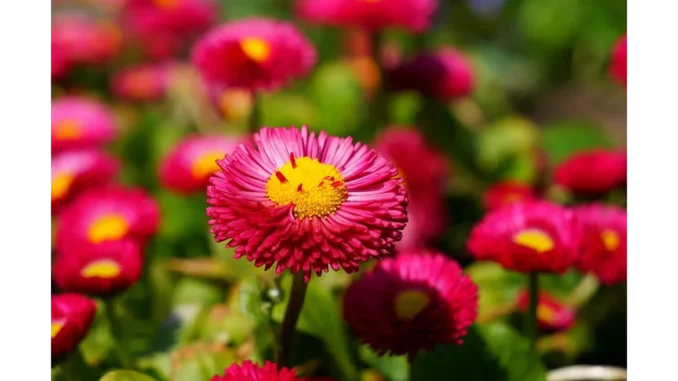
By John Williams
When it comes to rock gardening, the selection of plants plays a pivotal role in ensuring the garden’s enduring beauty and success. Recently, I had the pleasure of speaking with Emma Green, a seasoned horticulturist with a deep passion for rock gardens. Her insights provide invaluable guidance for anyone looking to create a thriving rock garden in the face of challenging conditions and limited soil.
The Importance of Plant Selection
Emma began by emphasising the critical importance of choosing the right plants for rock gardens. “Rock gardens are unique in that they often face harsh conditions—minimal soil, extreme temperatures, and limited water availability,” she explained. “Selecting plants that can withstand these conditions is key to creating a sustainable and visually appealing garden.”
Drought-Resistant Champions
Among the top choices for rock gardens, succulents reign supreme. “Succulents are the kings and queens of drought resistance,” Emma noted with a smile. “Their ability to store water in their leaves allows them to thrive in rocky environments where water is scarce.” She highlighted a few of her favourite varieties:
-
Golden Barrel Cactus (Echinocactus grusonii): “This cactus is a showstopper with its spherical shape and vibrant yellow spines,” said Emma. “It’s not only visually striking but also incredibly hardy.”
-
Foxtail Agave (Agave attenuata): Emma described this plant as “a touch of elegance,” with its long, arching leaves that resemble a fox’s tail. “It’s perfect for adding architectural interest to your rock garden.”
-
Blue Chalk Sticks (Senecio mandraliscae): “These have a beautiful blue-grey hue that contrasts wonderfully with the earthy tones of rocks,” she said. “Plus, they spread nicely, covering ground efficiently.”
Native Plants: Nature’s Gift to Rock Gardens
Emma also stressed the importance of incorporating native plants into rock gardens. “Native plants are adapted to the local environment, making them naturally resilient and low-maintenance,” she explained. “They also support local wildlife, which is a bonus for biodiversity.”
One example Emma provided was the Rock Cress (Arabis hybrida). “It’s a versatile groundcover with lovely white, purple, or pink flowers,” she said. “It’s also a magnet for butterflies, adding a touch of life to your garden.”
Creating Depth and Texture
A well-designed rock garden is not just about hardy plants; it’s also about creating visual interest through variation in height, texture, and colour. “You want a mix of plants that offer different shapes and sizes,” Emma advised. “This creates depth and makes the garden more visually appealing.”
She recommended using taller plants like the Madagascar Palm (Pachypodium lamerei) as focal points. “Its spiky trunk and tropical leaves make it a standout feature,” she noted. For mid-level interest, she suggested Gollum Jade (Crassula ovata ‘Gollum’) with its tubular, quirky leaves. “It’s a fun plant that adds character,” she said.
For ground cover, Emma praised Creeping Thyme (Breckland thyme). “It’s not only beautiful with its tiny flowers but also aromatic,” she said. “Perfect for filling in spaces between rocks and adding a sensory element to your garden.”
Design Tips for a Stunning Rock Garden
Emma shared several design tips to help gardeners get started:
-
Choose the Right Location: “Your rock garden needs at least six hours of sunlight daily,” she explained. “Good drainage is also crucial, so avoid areas near large trees or shrubs.”
-
Plan Before Planting: “Sketch out your design on paper or use landscaping software,” she suggested. “This helps you visualise the final look and ensures you have the right materials.”
-
Incorporate Colour and Texture: “Mixing different sizes and shapes of rocks adds dimension,” she said. “Experiment with plant combinations to achieve your desired aesthetic.”
-
Consider Water Features and Lighting: “Adding a small fountain or LED lights can enhance the garden’s appeal,” Emma noted. “Just ensure good drainage for water features.”
Caring for Your Rock Garden
Maintenance is minimal but crucial. “Water your drought-tolerant plants sparingly, every two to three weeks,” Emma advised. “Overwatering can be detrimental.”
She also recommended using well-draining soil and avoiding high-nitrogen fertilisers. “A balanced, slow-release fertiliser in early spring is ideal,” she said. “And don’t forget to clean your rock garden periodically to remove debris.”
Final Thoughts
Rock gardens offer a unique blend of natural beauty and low-maintenance appeal. With the right plant selection and design, they can transform any outdoor space into a stunning oasis. Emma’s expertise illuminates the path to creating a rock garden that is both resilient and captivating.
“Remember, the key is to choose plants suited to your environment,” Emma concluded. “With a bit of planning and care, your rock garden will thrive and bring joy for years to come.”
John Williams


Be the first to comment